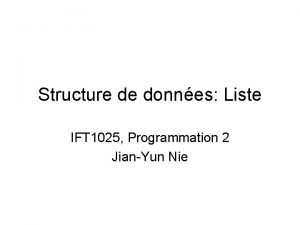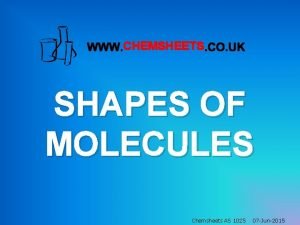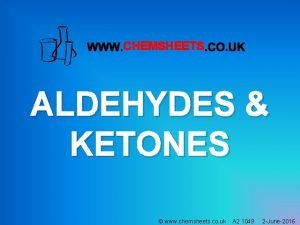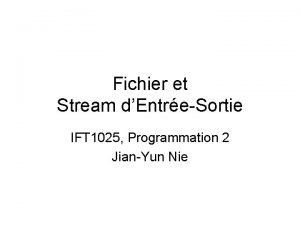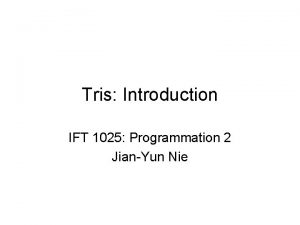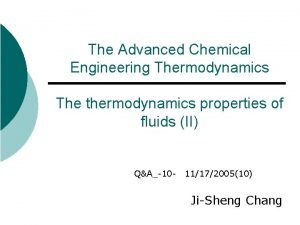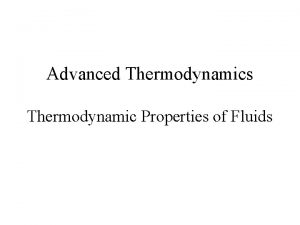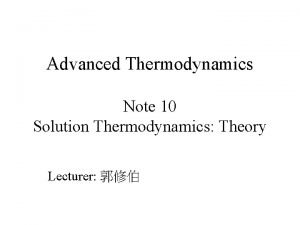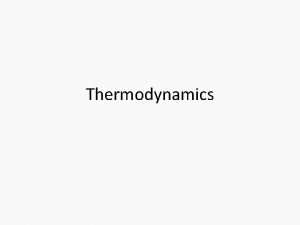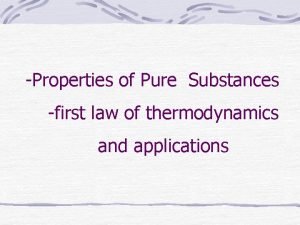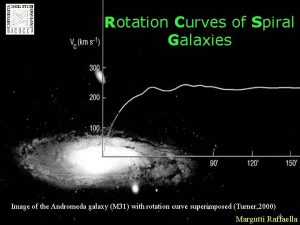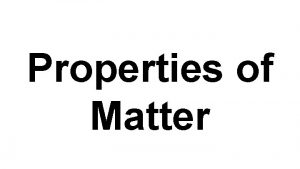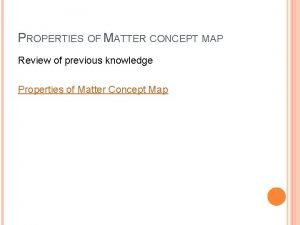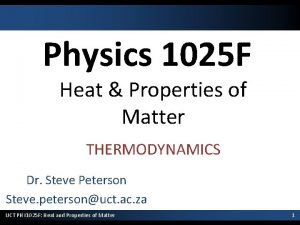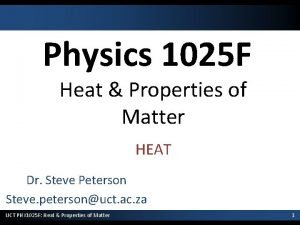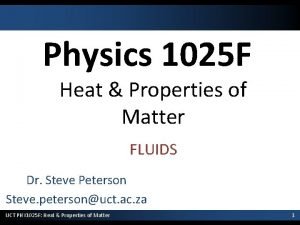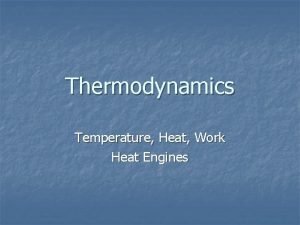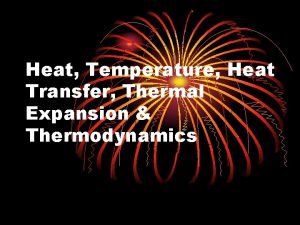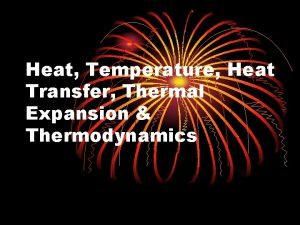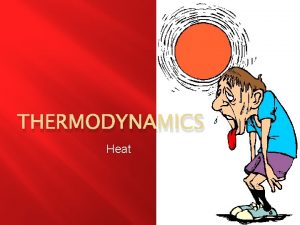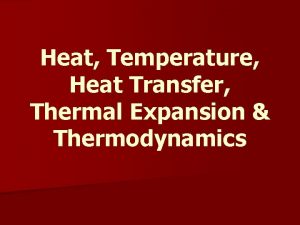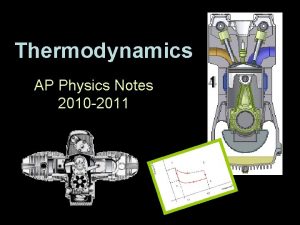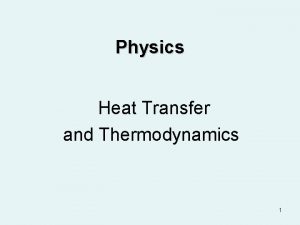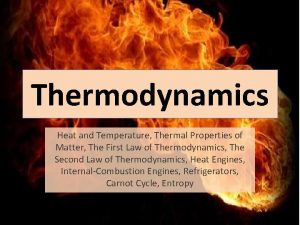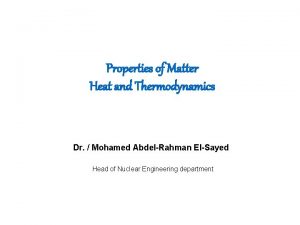Physics 1025 F Heat Properties of Matter THERMODYNAMICS





























- Slides: 29

Physics 1025 F Heat & Properties of Matter THERMODYNAMICS Dr. Steve Peterson Steve. peterson@uct. ac. za UCT PHY 1025 F: Heat and Properties of Matter 1

Chapter 15: Thermodynamics is the study of heat and work. UCT PHY 1025 F: Heat and Properties of Matter 2

Known: The Ideal Gas Law Assume that you are familiar with the ideal gas law: where n is the number of moles and R is the universal gas constant. Note: the term “ideal” is used because real gases do not follow this equation precisely. However, at pressure near 1 atm and temperatures near room temperature, it is quite accurate. UCT PHY 1025 F: Heat and Properties of Matter 3

Where does the Energy go? When energy is added to a substance what happens? OPTION 1: the object’s temperature may increase… OPTION 2: the phase of the substance may change… OPTION 3: the substance may use that energy to do work (i. e. expand) – First Law of Thermodynamics UCT PHY 1025 F: Heat and Properties of Matter 4

First Law of Thermodynamics: Work Consider a gas contained by a cylinder (volume V) fitted with a moveable piston at uniform pressure P. Determine the work done by the gas at constant pressure (isobaric process). UCT PHY 1025 F: Heat and Properties of Matter 5

First Law of Thermodynamics: Work When the gas expands ΔV is positive The work done by the gas is positive When the gas is compressed ΔV is negative The work done by the gas is negative When the volume stays constant No work is done by the gas UCT PHY 1025 F: Heat and Properties of Matter 6

First Law of Thermodynamics: Work done through volume change: The work done by the gas can also be calculated using a PV diagram, by calculating the area under the curve. Work done by the gas depends on the path followed. UCT PHY 1025 F: Heat and Properties of Matter 7

First Law of Thermodynamics The change in internal energy (DU) of a closed system will be equal to the heat (Q) added to the system minus the work (W) done by the system on its surroundings. This is the law of conservation of energy, written in a form useful to systems involving heat transfer. UCT PHY 1025 F: Heat and Properties of Matter 8

First Law of Thermodynamics The change in internal energy of a closed system will be equal to the heat added to the system minus the work done by the system on its surroundings. UCT PHY 1025 F: Heat and Properties of Matter 9

Thermodynamics Terminology System: collection of objects one is interested in Surroundings: everything else Typically, system = gas State of a system: a complete set of variables describing the system (pressure, volume, temperature, …) UCT PHY 1025 F: Heat and Properties of Matter 10

First Law of Thermodynamics For the First Law of Thermodynamics, the sign conventions are very important. It can be tricky trying to remember when Q and W are positive and negative. For heat Q: Heat flows into a system: Q > 0 Heat leaving the system: Q < 0 The amount of heat flowing into (or out of a system also depends on the path taken UCT PHY 1025 F: Heat and Properties of Matter 11

First Law of Thermodynamics Suppose system gains heat Q while no work is done By conservation of energy, the internal energy of the system changes: U increases if system gains heat U decreases if system loses heat Heat Q is positive when the system gains heat and negative when the system loses heat UCT PHY 1025 F: Heat and Properties of Matter 12

First Law of Thermodynamics Suppose system does work W on surroundings while no heat flows By conservation of energy, the internal energy of the system decreases: U decreases if work done by system U increases if work done on system Work W is positive when it is done by the system and negative when it is done on the system UCT PHY 1025 F: Heat and Properties of Matter 13

Ideal-Gas Processes We can represent the state of a gas by a point on a p. V diagram. A process can be represented by a path on this diagram. UCT PHY 1025 F: Heat and Properties of Matter 14

Thermodynamic Processes A quasi-static process occurs slowly enough that a uniform temperature and pressure exist throughout all regions of the system at all times We will consider 4 different thermal processes: isobaric: constant pressure isovolumetric: constant volume adiabatic: no transfer of heat isothermal: constant temperature UCT PHY 1025 F: Heat and Properties of Matter 15

Thermodynamic Processes: Isobaric An isobaric process is one that occurs at constant pressure Work done: area under PV curve Isobaric process: UCT PHY 1025 F: Heat and Properties of Matter 16

Problem: Isobaric Process What is the change in internal energy of the system after 1 g of water (at 100 o. C) is converted to steam? Assume process is done at atmospheric pressure. (Lv for water = 2256 x 103 J/kg, 1 g of water = 1671 cm 3 of steam) UCT PHY 1025 F: Heat and Properties of Matter 17

Thermodynamic Process: Isovolumetric An isovolumetric (or isochoric) process is one that occurs at constant volume Work done: area under PV curve Isovolumetric process: UCT PHY 1025 F: Heat and Properties of Matter 18

Problem: Isovolumetric Process V&S Example 12 -7: How much thermal energy must be added to 5. 00 moles of monatomic ideal gas at 300 K and with a constant volume of 1. 5 L in order to raise the temperature of the gas to 380 K? UCT PHY 1025 F: Heat and Properties of Matter 19

Thermodynamic Processes: Adiabatic An adiabatic process is one in which no heat flow occurs Adiabatic Expansion: Tf < Ti Adiabatic Compression: Tf > Ti Adiabatic process: UCT PHY 1025 F: Heat and Properties of Matter 20

Problem: Adiabatic Process In the PV diagram shown alongside, 85. 0 J of work was done by 0. 0650 mole of an ideal monatomic gas during an adiabatic process. a) How much heat entered or left this gas from a to b? b) By how many joules did the internal energy of the gas change? c) What is the temperature of the gas at b? d) What is the temperature of the gas at a? UCT PHY 1025 F: Heat and Properties of Matter 21

Thermodynamic Processes: Isothermal An isothermal process is one that occurs at constant temperature Work done: area under PV curve Isothermal process: UCT PHY 1025 F: Heat and Properties of Matter 22

Problem: Isothermal Process C&J Example 15 -5: Two moles of the monatomic gas argon expand isothermally at 298 K, from the initial volume of 0. 025 m 3 to a final volume of 0. 050 m 3. Assuming that argon is an ideal gas, find (a) the work done by the gas, (b) the change in the internal energy of the gas, and (c) the heat supplied to the gas. UCT PHY 1025 F: Heat and Properties of Matter 23

Problem: Thermodynamic Processes A cylinder, fitted with a frictionless piston, contains 0. 250 moles of an ideal monatomic gas at an initial pressure of 6. 0 x 104 Pa and an initial volume of 3. 0 x 10 -3 m 3. The gas expands isobarically to twice its initial volume, and then its pressure is decreased isochorically to half its initial pressure. Finally it is compressed isothermally back to its original pressure and volume. a) Draw a PV diagram showing the three stages. b) Determine the amount of work done on or by the gas in each stage, and the amount of heat flowing into or out of the gas in each stage. A to B: W = +180 J, Q = +450 J B to C: W = 0, Q = -270 J C to A: W = -124. 7 J, Q = -124. 7 J UCT PHY 1025 F: Heat and Properties of Matter 24

Human Metabolism & The First Law We can apply the first law of thermodynamics to the human body: Work W is done by the body in its various activities. In order to maintain our internal energy level, there must be energy coming in. Energy does not enter the body through heat absorption, instead the body loses heat. Rather, the energy entering the body through the chemical potential energy stored in foods. UCT PHY 1025 F: Heat and Properties of Matter 25

Human Metabolism & The First Law The metabolic rate (ΔU / Δt) is the rate at which internal energy is transformed in the body. UCT PHY 1025 F: Heat and Properties of Matter 26

Measuring Metabolic Rate The metabolic rate is related to oxygen consumption by About 80 W is the basal metabolic rate, just to maintain and run different body organs UCT PHY 1025 F: Heat and Properties of Matter 27

Aerobic Fitness One way to measure a person’s physical fitness is their maximum capacity to use or consume oxygen UCT PHY 1025 F: Heat and Properties of Matter 28

Efficiency of the Human Body Efficiency is the ratio of the mechanical power supplied to the metabolic rate or total power input UCT PHY 1025 F: Heat and Properties of Matter 29
 Mit 1025
Mit 1025 Ift 1025
Ift 1025 Ift 1025
Ift 1025 Ift1025
Ift1025 Ift1025
Ift1025 Chemsheets as 1017 shapes of molecules
Chemsheets as 1017 shapes of molecules Reactions of aldehydes and ketones chemsheets answers
Reactions of aldehydes and ketones chemsheets answers Ift 1025
Ift 1025 Ift 1025
Ift 1025 Ift 1025
Ift 1025 Ift 1025
Ift 1025 1025 ce
1025 ce Residual properties in thermodynamics
Residual properties in thermodynamics Advanced thermodynamics
Advanced thermodynamics Fugacity
Fugacity Thermodynamics intensive and extensive properties
Thermodynamics intensive and extensive properties Properties of pure substances thermodynamics
Properties of pure substances thermodynamics Classification of matter section 1 composition of matter
Classification of matter section 1 composition of matter Grey matter reliaquest
Grey matter reliaquest Classification of matter section 1 composition of matter
Classification of matter section 1 composition of matter Chapter 2 section 1 classifying matter answer key
Chapter 2 section 1 classifying matter answer key Optic tract
Optic tract Composition of matter section 1
Composition of matter section 1 Gray matter and white matter
Gray matter and white matter Telencephalon
Telencephalon Ecological succession
Ecological succession Dark matter physics
Dark matter physics Do
Do Properties of matter vocabulary
Properties of matter vocabulary Composition of matter concept map
Composition of matter concept map

